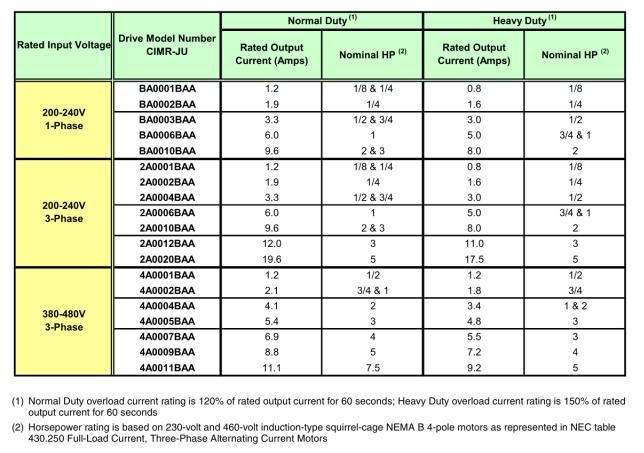Questions to Consider for Your Yaskawa Application
When you are thinking about purchasing a Yaskawa AC Drive, you have to decide whether a Normal Duty or Heavy Duty drive is required for the application. This applies to the J1000, V1000 & A1000 drive series.
Here is the selection chart for the J1000 drive from the catalog:

Same drive, two current ratings
The first thing to note is that for the same drive, there are two current ratings. Drives should always be sized based on the full load amps on the motor nameplate, not the horsepower rating. There is not a Normal Duty version and a Heavy Duty version of the drive – it is the same drive, but has different ratings based on what its application will be. A parameter is set in the drive to determine if it will act as a Normal Duty or a Heavy Duty drive. This sets the overload characteristics per note (1) in the table above. For example, for the last drive in the table, CIMR-JU4A0011BAA, if it is set as a Normal Duty drive it will generate an overcurrent alarm at 13.3A (11.1 x 120%); if set as a Heavy Duty drive it will generate an overcurrent alarm at 13.8A (9.2 x 150%). Other motor parameters in the drive are set based on the usage as well.
What is a Normal Duty type?
The question naturally arises as to what constitutes a Normal Duty type of application as opposed to a Heavy Duty type of application. According to the technical manuals for the J1000, V1000 & A1000:
“Use Heavy Duty Rating for applications requiring a high overload tolerance with constant load torque, such as extruders and conveyors. Use Normal Duty Rating for applications in which the torque requirements drop along with the speed, such as fans and pumps where a high overload tolerance is not required.”
More specifically, the manuals give the following guidance: “Fans, pumps and blowers should use Normal Duty… and other applications generally use Heavy Duty.”
If you’re still uncertain which drive to specify for your particular application, contact the experts at Cross Automation.
